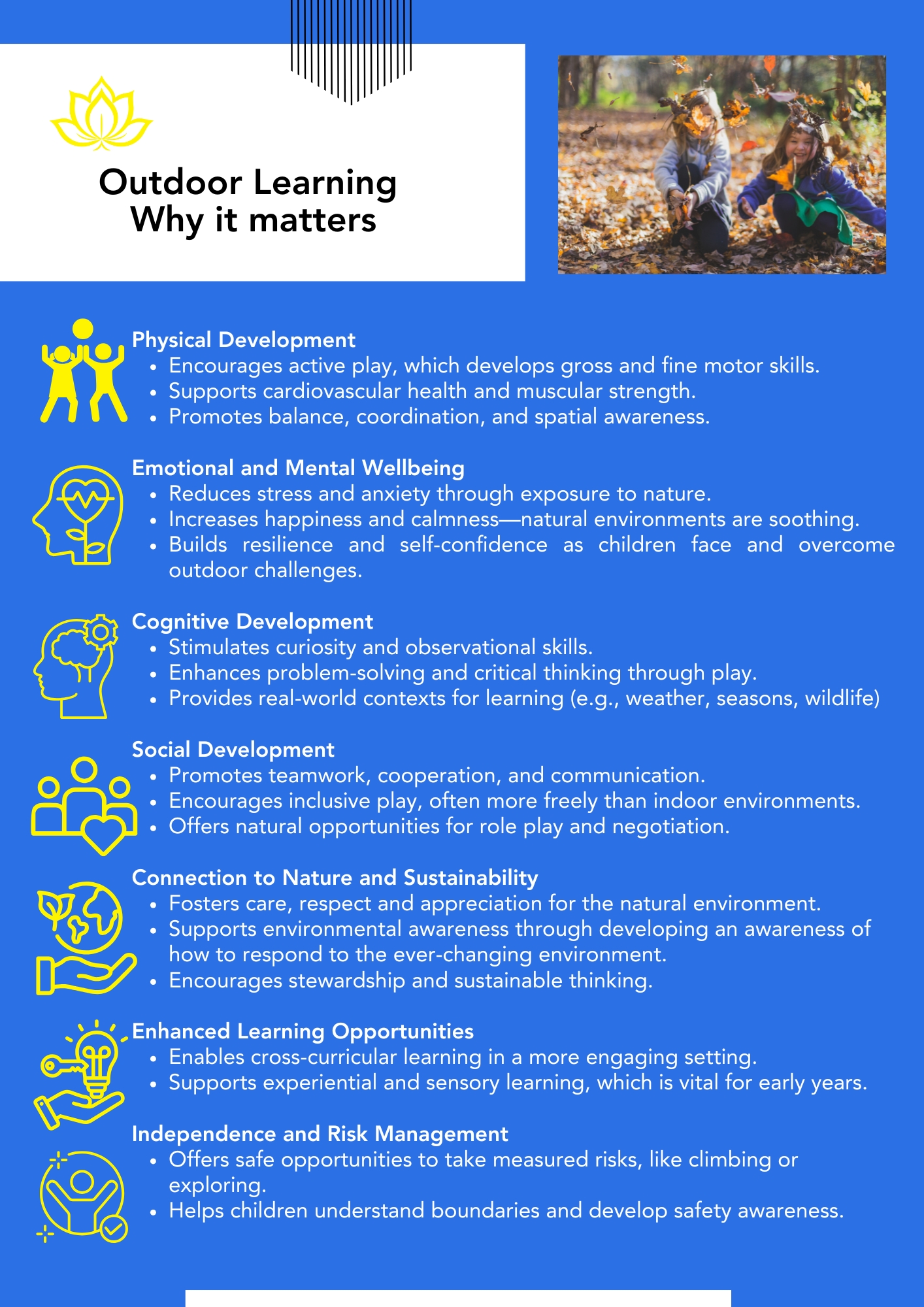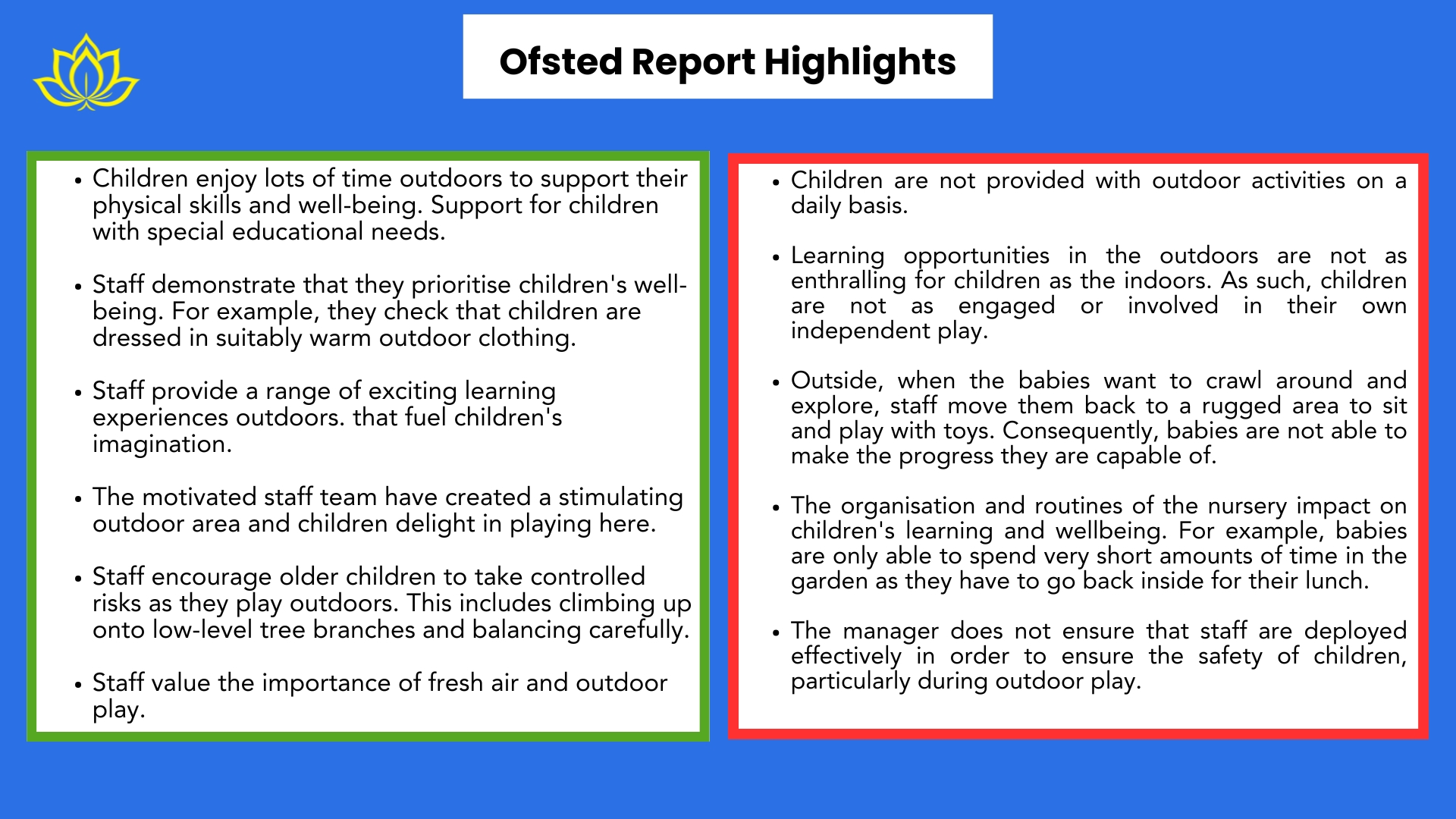A setting who gets this right will…
- Support children’s development more – builds resilience, problem-solving skills, and physical health through year-round outdoor play.
- Boost staff confidence – equips practitioners with strategies and resources to lead engaging sessions in all conditions.
- Enhance wellbeing – fresh air and active play reduce stress levels and improve mood for both children and staff.
- Delight parents and inspectors – demonstrates a commitment to high-quality, adventurous learning experiences whatever the weather.
Why does this matter?

From a young age, children are naturally curious about the outdoor environment.
Children now spend less outdoors than previous generations. Due to a number of factors:
- Number of children living in accommodation without garden space
- Parental concerns over safety and traffic
- Reduced access to open spaces
- Increased use of modern technology, although this has been said to have a positive impact on children’s interest in natural environment.
Our role is to ensure children have opportunities to explore the outdoor environment and connect with nature. In accordance to the EYFS guidelines.
What do Ofsted Reports capture?

The Statutory Framework
Providers must provide access to an outdoor play area. If that is not possible, they must ensure that outdoor activities are planned and taken on a daily basis (unless circumstances make this inappropriate, for example unsafe weather conditions). Providers must follow their legal responsibilities under the Equality Act 2010 (for example, the provisions on reasonable adjustments).
A little bit of theory
Friedrich Fröebel (1782-1852)
He considered the outdoors to be essential for children’s wellbeing and development. He wanted children to understand the natural world, to learn to look after it and appreciate it. His kindergartens were a place where children could play freely and observe and interact with nature but also provided them the opportunities to grow and develop. The importance of the outdoor environment where children can be physically active, grow things, climb, sing and dance.
Margaret McMillan (1860-1931)
McMillian was influenced by Froebel. Margaret and her sister Rachel McMillan opened an open-air school in 1911 for children from the age of six to fourteen to focus on holistic education and improve health and behaviour. She believed that nature’s own healing powers and beauty was hugely important in the lives of young children. Next, she set up an open air nursery in 1914 for younger children with the emphasis on lots of fresh air
Maria Montessori (1870- 1952)
Montessori believed that all children should develop an appreciation and interest in their environment both indoors and outdoors, through being loving, responsible and respectful for their environment. All of this was done through role modelling by the teacher and using real but small sized household tools such as gardening tools, brooms, dustpans, watering cans. The children were involved in all parts of the tidy up process not just putting things away but sweeping and clearing so that the environment is prepared for its next use.
Task One – Reflect as a team
Do you and your team enjoy taking the children outside in the colder months?
- Do you have staff members who are reluctant to go outside in the winter months or when it is cold/wet or rainy?
- Are learning opportunities for the children being missed because of this?
- Are the children missing outdoor play because staff refuse to take them out?
Take it further:
- What is your settings policy on going outside with the children?
- What is listed on the website and what information is communicated at parent visits? Perhaps it says you go outside twice a day in all weathers.
- Are there times when you haven’t met this expectation, if so, what are the reasons why?
Do you have a team meeting come up or would you like to have a deeper reflection discussion? Check out the reflective scenarios below and even create your own!
Learning opportunities that embrace the weather
There is no such thing as bad weather, but there is such a thing as inappropriate clothing.
We can educate ourselves on what to wear outside and be more prepared for all weathers. (Read our top tips sheet!)
- Keeping active outside will help to keep us warm.
- We should embrace the weather and create some new and exciting opportunities from it.
Remember we are role models to the children, if we walk around with our hands in our pockets moaning about the cold and wet they are likely to copy this behaviour too.
Meeting the standards that we set out to our parents. If the nursery brochure states that you take the children out in all weathers then that is what the parents expect.
Wouldn’t it be great to have happy and engaged adults playing with the children in all weathers and showing the children the importance of going outside? Yes, it would!
Life isn’t about waiting for the storm to pass. It’s about learning how to dance in the rain.
Vivian Greene
“A ship is safe in harbor, but that’s not what ships are for.” –
John A. Shedd
10 Rainy day ideas
- Allow children to stand in puddles if wearing welly boots and record depths of puddles by marking it on their boots with chalk.
- Adding powder paint to the puddles to encourage colour mixing.
- Adding washing up liquid to puddles to make them bubbly.
- Connected to the above if the puddles are on a hard surface, sweep the puddles to create mini waves.
- Using the parachute on a rainy day and hearing the rain drop on it.
- Using boats or ducks to float in the puddles.
- Transferring water from the puddles using spoons, syringes, pumps or basters.
- Decorate a paper towel/coffee filter paper with felt tip pens and watch what happens when you put it out in the rain.
- Compare welly boot prints in the mud.
- Using umbrellas or tarpaulin to make a shelter and listening to the sounds of the rain on it – you could add different textures – tin foil, wool etc.
Ice – The season to sparkle
- Watching how fast ice melts by warming it or adding salt with a salt shaker.
- Using tools to dig items out of the ice. This is a good one to prepare if you know it is going to freeze over night. Place items in a tuff tray/bucket/container and cover with water. Place it outside and let nature takes it course.
- If you have tyres in your outdoor environment you could fill the rims with water and let these freeze and then provide tools such as scoops for the children to scoop out the ice.
- Painting on ice.
- Examining ice through a magnifying glass.
- Creating an arctic animal scene.
- Using tools to crack the ice and listening to the sound that it makes.
- Using spoons, scoops or ladles to transfer ice from container to container.
- Using small world people/animals can they travel over the ice without breaking it or how far can they slide on the ice.
- Using ice as a window to look through.
Snow – When life gives you snow, make snow angels
- Make a snowman/dog out of snow and compare sizes.
- Painting on snow, you could build a snowman and then use paints to decorate him.
- Spray painting the snow – watered down paint/food colouring in spray bottles.
- Make a volcano with bicarbonate of soda and vinegar.
- Use ice cube trays to make mini snow blocks so that you could create an igloo for your small world people.
- Use snow to make some pretend ice creams.
- Make different size snowballs – what is the biggest or smallest you can make.
- Use the toy diggers or tractors to transport snow around the garden.
- Compare foot prints – sizes of boots or the patterns that they create.
- See how quickly you can melt some snow by rubbing it together or leaving it in the sun.
- Make a snow angel.
- Use the small world people in a tuff tray.
Wind – When the wind blows, the grass bends, it doesn’t fall over
- Flying a kite.
- Blowing dandelion heads (or watching the wind blow them for you).
- Blowing bubbles (or watching the wind blow them for you).
- Have a boat race in the water tray.
- Using fishing nets to see how many leaves you can catch.
- Attach mini parachutes to your small world people.
- Watch clouds racing across the sky.
- Explore the force of the wind by running into it and then running away from it.
- Throw handfuls of leaves up in the air and watch them fall or chase them around.
- Building a tower with light cardboard boxes or foam cubes and see whose resists the wind the longest before it falls down.
- Attach sensory items that will move in the wind to a washing line and watch and listen to the sounds that they make.
Cold – The cold never bothered me anyway
- If you have a water wall, use other items such as small cars, balls to roll down or up.
- Using the water wall with a smaller amount of water but use warm water.
- Acting out a story instead of sitting down and let the story travel around to different parts of the nursery garden to help keep everyone warm with saying that is what you are doing. E.g Going on a bear hunt.
- Activities using ramps that encourage children to run after the objects – short bursts of keeping warm.
- A good old pot of bubbles, blow some bubbles and see if they freeze.
- Scavenger/finding/listening activities that help them to move around outside to keep warm.
- Building a den – either small scale to keep the small world animals warm or large scale for the children to use it.
- Drawing with chalk.
- Obstacle courses providing it is not slippy are a good way to get the children moving around outside.
Task Two – Reflection unlocks deeper thinking
Have a go at these reflective scenarios and create your own too.
What does it mean to dress appropriately?


8 ways to overcome obstacles
- Could you create a simple box containing some of these items to take outside during the winter months.
- How do you make sure the staff are going outside – make this non negotiable. Staff are accountable for why they haven’t gone outside.
- Challenge the mindset around going outside, leading by example.
- Bring some of the indoor resources outdoors to create some new learning opportunities.
- Each setting is different – ensure you are risk assessing for your own environment.
- Could you provide some funding for outdoor clothing or have spare items that staff and children can borrow to ensure they can go outside.
- Ask the children what they would like to do outside.
- Talking to the children about what you are going to do outside and making a plan makes you more accountable.
GIST – Good ideas for starting things…
- What 3 ideas would you implement into your setting? What impact will they bring? Are they things you can do today, this week, this month, or later?
- [More?]
Want to learn more?
- https://early-education.org.uk/outdoor-learning-in-the-early-years/
- https://www.eyalliance.org.uk/benefits-outdoor-play-early-years
- https://www.theoutdoorsproject.co.uk/news/childrens-mental-health-week-benefits-of-outdoor-play/#:~:text=Enhancing%20Physical%20and%20Mental%20Health,improve%20mood%2C%20and%20promote%20relaxation.
- https://www.cam.ac.uk/research/news/lockdown-wellbeing-children-who-spent-more-time-in-nature-fared-best
- https://dingley.org.uk/outdoor-learning-in-the-early-years/
- Other educationalists to look up:
- Kathryn Solly
- David Sobel
- Juliet Robinson
